35 F. high in the Twin Cities Friday.
28 F. average high on December 12.
19 F. high on December 12, 2013.
Trace of snow on the ground in the Twin Cities (MSP International Airport).
December 12, 1995: A low pressure system moved across northern Minnesota depositing a band of five to seven inch snowfall along a line from around Wheaton, to north of St. Cloud, to around Rush City. Alexandria received seven inches of snow. Meanwhile in southern Minnesota, one to four inches of snow fell, along with one-quarter to one-half inch of freezing rain, which forced some school closures.
December 12, 1821: Cold snap begins at Ft. Snelling. Below zero for 19 days except one.

Fog, Smog & Drizzle
Minnesota’s weather is about as interesting as a test pattern. Remember those? I’m dating myself. The Doppler is temporarily unplugged; I’ve hacked the weather computer to play endless games of Madden NFL 15.
This is what an El Nino winter looks like: gray, damp, but above zero most of the time. Boring has never looked so good, here in a land where 40F can earn a weather guy a high-five.
Yesterday it was above 60F some 4,000 feet above the Dakotas. A stubborn inversion has put a lid on the atmosphere: warm air aloft, chilly air at ground-level; no churning and overturning of the air. The result: fog and a mid-winter smog, as particulate pollution becomes trapped near the surface. A little light rain and drizzle is likely today and Sunday as temperatures poke into the 40s; more typical of early March.
El Nino winters tend to be milder and drier for Minnesota, as the biggest storms track from California to Texas, then right up the East Coast. Our models hint at a mix ending as a couple inches of snow Monday before cooling off next week. Nothing frigid brewing looking out 2 weeks.
Will the coolest year since 1996 include a white Christmas?
It’ll be a close call.
* Photo credit: Steve Burns Photography.
* Air Quality Advisory still in effect; an inversion will trap pollutants near the ground today and tomorrow with conditions improving early next week as cooler air arrives and winds increase. Details from AirNow.

Dense Fog Advisory. Mild, Pacific air passing over cold ground will be chilled from below, sparking thick fog, drizzle and a little light rain today. Details from the Twin Cities National Weather Service:
DENSE FOG ADVISORY IN EFFECT UNTIL 11 AM CST SATURDAY... THE NATIONAL WEATHER SERVICE IN TWIN CITIES/CHANHASSEN HAS ISSUED A DENSE FOG ADVISORY...WHICH IS IN EFFECT UNTIL 11 AM CST SATURDAY. * VISIBILITY...1/4 MILE OR LESS. * IMPACTS...DRIVING MAY BE IMPACTED WITH LIMITED VISIBILITIES. PRECAUTIONARY/PREPAREDNESS ACTIONS... A DENSE FOG ADVISORY MEANS VISIBILITIES WILL FREQUENTLY BE REDUCED TO LESS THAN ONE QUARTER MILE. IF DRIVING...SLOW DOWN... USE YOUR HEADLIGHTS...AND LEAVE PLENTY OF DISTANCE AHEAD OF YOU.

Mild Spurt, Then Back To Average. I’m not convinced we’ll hit 48F today or 55F tomorrow. Subtract 5-7F due to a sharp inversion and thick fog, but it will still feel pretty good out there: fog and drizzle today, a better chance of a little light rain tomorrow, ending as a period of snow Monday. Canadian air drops temperatures back down to normal for mid-December after Tuesday, but at least the sun will be out from time to time. Graphic: Weatherspark.
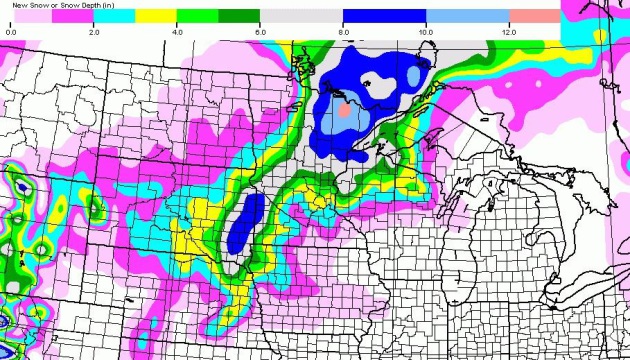
Monday: Nuisance to Plowable Snowfall? It’s still early to be throwing around inch-amounts, but models are converging on a couple inches of snow for the Twin Cities, with more north and west of MSP, possibly a plowable snow for portions of western, central and northern Minnesota. GFS guidance above courtesy of NOAA.

California Mega-Storm Pushes East. The same storm that roughed up northern California Thursday and SoCal Friday will push heavy snow across the Rockies; a smear of rain expanding northward across the Plains by Monday. This is the same system that may drop a few inches of snow close to home late Monday and Monday night.
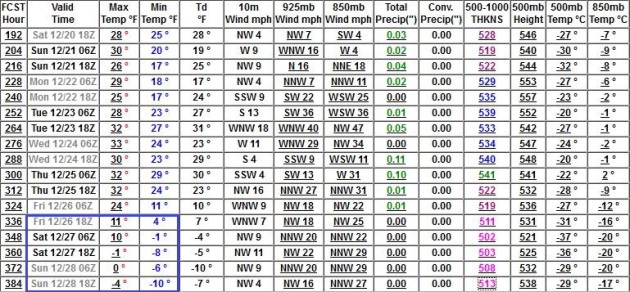
Sharply Colder After Christmas? GFS guidance shows single digits and teens immediately after Christmas, nighttime lows dipping below zero December 27-29. The pattern is progressive; no evidence the pattern will become locked into an extended period of Arctic air. Not yet.

The Climate Context of California’s Atmospheric River Storm. All or nothing, from the worst drought in 1200 years to a parade of flooding storms, courtesy of El Nino, spiked by a warmer Pacific and more water vapor in the air, increasing the potential for extreme rains. Here’s an excerpt from Climate Nexus: “…Atmospheric river storms are responsible for 30-50 percent of all the precipitation in California and are also responsible for over 80 percent of major flooding events. Climate research indicates that the impacts of these storms are expected to escalate dramatically if carbon emissions continue along the business-as-usual path, and that atmospheric rivers may already be impacted by current warming:
- As the world heats up and more heat is carried in the atmosphere as water vapor, heavy precipitation events are becoming more intense.
- Climate models project that atmospheric river storms in California will become more frequent and intense in the future, which means it is likely that the current storm is a taste of what’s to come...”
* image courtesy of CIMSS, University of Wisconsin, Madison.
** A small tornado in south Los Angeles Friday? KABC-TV has the footage here.

23 Minnesota Tornadoes in 2014. Yes, it was fewer than average; the coolest year for Minnesota since 1996 took the edge off the tornado count – Dr. Mark Seeley has more details in the latest edition of Minnesota WeatherTalk: “…This week Todd Krause of the NOAA-National Weather Service in Chanhassen, MN provided a summary of tornado reports across the state this year. Only 23 tornadoes were reported in the state during 2014, the second consecutive year with a smaller than average number (only 15 reports in 2013)…”

2014: One Of The Least Active Tornado Years On Record For The USA. Here’s an excerpt of a story at The Washington Post: “…At least 400 fewer tornadoes than average have touched down in the U.S. this year, making it one of the quietest years on record for twisters, according to the National Weather Service (NWS). Whereas an average of 1,260 tornadoes form each year in records dating to the early 1950s, only 823 have occurred in 2014 through November, says Greg Carbin, warning coordination meteorologist at the NWS Storm Prediction Center, in Norman, Okla…”

“How’s The Weather?” Becomes a Loaded Question. Yes, we are all armchair meteorologists (and climate experts) now. Here’s an excerpt from a New York Times article: “…According to a recent report by the World Bank Group, extreme weather events could become the new “climate normal.” In this world of “increased risks and instability,” it seems we find comfort in being armed with the facts. With access to the storm-surge of information on our smartphones, we are all meteorologists now. Just a few years ago, terms like extreme snowfall or polar vortex were familiar only to professionals; today, they are bandied about in coffee shops and office elevators…”

Study: Hot Temperatures Rising Faster Than Cold Temperatures Over Last 30 Years. Meteorologist Jason Samenow has the story at The Washington Post’s Capital Weather Gang – here’s a snippet: “…As the Earth has warmed over the last three decades, it’s the warmest temperatures that have warmed the most, a new study finds…To put it another way, the long-term trend shows global warming concentrated on easing the severity of the most extreme winter cold, while the short term trend shows warming focused on intensifying some of the most oppressive heat…”
Graphic credit above: “Spatial patterns of temperature differences from normal for April 1998.” (University of Indiana)
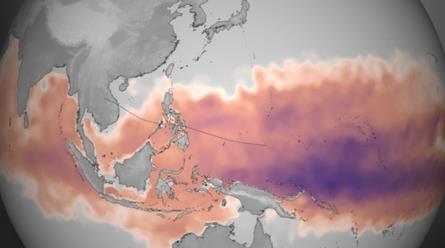
Warm Ocean Waters Boosting Typhoons, Record Heat. The Atlantic was relatively quiet (again), but the Pacific was anything but, as highlighted in this excerpt from Climate Central: “… Also rare for the Atlantic would be the five Category 5-strength storms that have spun up in the West Pacific this year, the most in that basin since the 10 seen in 1997, according to Steven Bowen, an associate director and meteorologist with the reinsurance group Aon Benfield. The record for Category 5 storms in a single season in the Atlantic is only four, which has only happened once, during the blockbuster 2005 season. The West Pacific, on the other hand, has averaged about three Category 5 storms a season since 2000, Bowen said. The five storms this season have still been noteworthy, and one reason there have been so many are the warm waters that have been in place across the Pacific. The waters that allowed Hagupit to rapidly strengthen last week were about 2°F warmer now than this time last year, Bowen said…”
Map credit above: “Graphic showing the total amount of heat energy available for Super Typhoon Haiyan to absorb, not just on the surface, but integrated through the water column. Deeper, warmer pools of water are colored purple, though any region colored from pink to purple has sufficient energy to fuel storm intensification. The dotted line represents the best-track and forecast data as of 16:00 UTC on Nov. 7.” Courtesy of NOAA.

DHS Admits Catastrophic Impact of EMP. A severe X-class solar flare could knock the USA back to the mid 1800s; it might take years to get the power grid back up in a worst-case scenario. Here’s the intro to a sobering assessment at WND.com: “Buried in a 303-page report is an assessment by the Department of Homeland Security that a massive electromagnetic pulse event caused by a solar flare could leave more than 130 million Americans without power for years. In spite of the admission of the cataclysmic consequences of an EMP event, DHS still has not added the threat to its 15 National Planning Scenarios…”
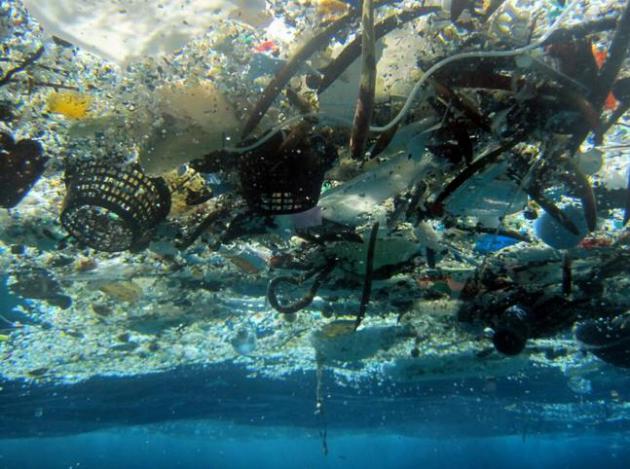
Study Shows That 270,000 Tons of Plastic Float In The Oceans. Here’s the intro to a troubling story from AP and Huffington Post: “A new study estimates nearly 270,000 tons of plastic is floating in the world’s oceans. That’s enough to fill more than 38,500 garbage trucks. The plastic is broken up into more than 5 trillion pieces, said the study published Wednesday in the scientific journal PLOS ONE…”
File photo credit above: “This file 2008 photo provided by NOAA Pacific Islands Fisheries Science Center shows debris in Hanauma Bay, Hawaii. A new study estimates nearly 270,000 tons of plastic is floating in the world’s oceans. That’s enough to fill more than 38,500 garbage trucks if each truck carries 7 tons of plastic. The figure appears in a study published, Wednesday, Dec. 10, 2014, in the scientific journal PLOS ONE. Researchers say the plastic is broken up into more than 5 trillion pieces.” (AP Photo/NOAA Pacific Islands Fisheries Science Center, File).

Sony Pictures Hack: The Whole Story. Welcome to the opening salvo of CyberWarfare, with the first volleys of pain directed at a major global corporation. This redefines the meaning of “hack”. Here’s an excerpt from Engadget: “…Baumgartner says the malware used to harm Sony Pictures, known as Destover, acts as a backdoor and is capable of wiping disk drives and any Master Boot Record disk — in other words, it can sneak into a system, completely take over and, just like that, have access to the data saved within. “It does not target consumers,” he added. “There may be other issues for customers, however, that arise out of any business being hacked and sensitive data accessed...”

Everyone’s Worst Page on the Internet. Some perspective on the Sony hack, and why everyone should pay close attention; here’s a clip from The Awl: “…Look at your laptop: It could destroy you, even if you’ve done nothing wrong. This realization should be compounded by the knowledge that most of what’s “on” your computer actually lives somewhere else, too, in the servers of companies that are interested in protecting your data only insofar as it preserves their business interests, which are, generally, variations on data marketing and the sale of advertising, to which appearances of privacy and security are helpful. Modern life is a digital nesting doll of latent blackmail opportunities and neglected, decaying data warheads…”

The NFL Has A Problem With Stem Cell Treatments. MIT Technology Review has a story that made me do a double-take; here’s the introduction: “Elite athletes do whatever it takes to win. Lately, that’s meant getting an injection of their own stem cells. The treatments, developed over the last eight years, typically involve extracting a small amount of a player’s fat or bone marrow and then injecting it into an injured joint or a strained tendon to encourage tissue regeneration. Bone marrow contains stem cells capable of generating new blood cells, cartilage, and bone…”
Photo credit above: “NFL quarterback Peyton Manning reportedly had a stem cell treatment to his neck in 2011.”

Where To Move If You Want A Job, More Money, Or Lot’s Of Single People. The Atlantic has the details; here’s the introduction: “Springfield, Massachusetts, is the most single. San Jose, California, is the most international (richest, too). Provo, Utah, is the youngest workforce in America, and McAllen, Texas, has the most minorities (and the poorest workers).Those are some of the tidbits you can scoop up from the new edition of the Census Explorer for young adults…”

How Much Longer Will You Live? O.K. This is a little morbid, but based on demographics, your age, where you were were born and where you live, Population.io can calculate how many years you have left. It doesn’t take current health into effect, so I’m a bit skeptical. Maybe it’s a defense mechanism. Pour yourself a stiff drink first. Oh, it calculated that I share a birthday with 185, 273 people, and I get an extra 3 years of life expectancy for living in the USA. I can’t say I’m looking forward to November 26, 2040, although by then I may be more than ready to meet my maker.

What’s The Point Of A Curved TV? One of many questions on my mind, now that 4K and curved TV’s are showing up at Costco and Best Buy. What’s the advantage? Here’s an excerpt at Gizmag: “…Soneira explains that the concave shape reduces the number of reflections on a screen by eliminating certain angles from which they can be created. “This is very important for a display technology that produces excellent dark image content and perfect blacks, because you don’t want that spoiled by ambient light reflected off the screen,” says Soneira. He also says that curved TVs improve the viewing experience for individuals sitting off-center. Soneira explains that the curve of the screen works to eliminate some of the unintended “foreshorteneing” caused by sitting to one side…”

TODAY: Fog, rain and drizzle. But milder. Winds: SW 8. High: 45
SATURDAY NIGHT: Foggy and damp, more drizzle. Low: 40
SUNDAY: Fog, mist and light rain. Bland but mild. High: 47
MONDAY: Rain ends as couple inches of snow? Wake-up: 37. High: 38 (falling during the day).
TUESDAY: Slippery start, colder wind arrives. Wake-up: 19. High: 26
WEDNESDAY: Peeks of anemic sunshine. Wake-up: 13. HIgh: 25
THURSDAY: Patchy clouds with light winds, another inversion. Wake-up: 18. High: 27
FRIDAY: Blah humbug. But good travel wx. Wake-up: 20. High: near 30
Climate Stories….
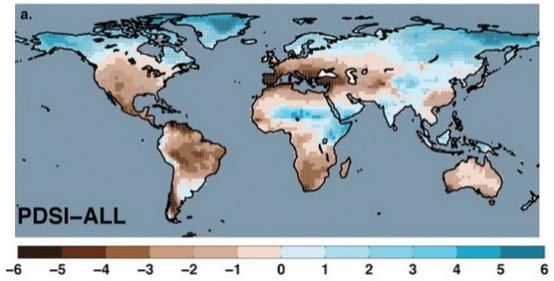
What We Learned About Climate Change in 2014, in 6 Scary Charts. Here’s an excerpt from ThinkProgress: “…The 2014 chart I consider the most important is not the prettiest or simplest. But it is the one that best captures our latest understanding of what has emerged as the greatest danger to humanity this century from human-caused climate change — Dust-Bowlification and the threat to our food supplies. This map of the global drying we face uses the Palmer Drought Severity Index (PDSI), a standard measure of long-term drought. It is excerpted from the study, “Global warming and 21st century drying…”
Graphic credit above: “Palmer Drought Severity Index (PDSI) for 2080-2099 with business-as-usual warming. By comparison, during the 1930s Dust Bowl, the PDSI in the Great Plains rarely exceeded -3 (see here).” Source: Cook et al. and Climate Progress.

How America Is Kicking Its Oil Habit. Bloomberg has the story; here’s the introduction: “The U.S. is producing the most oil in 31 years, economic growth is picking up and crude prices are plunging. So why is Americans’ use of petroleum waning? As the U.S. moves closer and closer to energy independence, greater fuel efficiency, changing demographics and an increase in renewables are altering the dynamic that in the past would have seen demand for gasoline climbing. Gross domestic product, the value of all goods and services produced in the U.S., grew at a 2.4 percent pace in the third quarter from the year-earlier period. Oil consumption fell 0.3 percent, government data show…”

Alarming Quantities of Methane Escaping From Pacific Seafloor, Scientists Warn. Remember, we don’t know what we don’t know. A comforting thought. That said, we might want to err on the side of caution. Here’s the intro to a story at Tech Times: “Scientists have discovered that water off the coast of Washington is warming at a depth where solid methane can transform into gas, indicating that the warming of the ocean is triggering the release of the heat-trapping greenhouse gas. Methane, which is several times more potent than carbon dioxide in fueling global warming, forms into methane hydrate wherein it gets enclosed in frozen water given the right conditions: cold temperature and high ocean pressure…” (File image: ThinkProgress).

Fact or Fiction? Geoengineering Can Solve Global Warming. Here’s a clip from a story at Scientific American: “…The world may find itself in need of another alternative, such as geoengineering, if catastrophic climate change begins to manifest, whether in the form of even more deadly heat waves, more crop-killing droughts, more rapid rises in sea level or accelerating warming as natural stores of carbon—such as the ocean’s methane hydrates—melt down, releasing yet more greenhouse gases to drive yet more climate change. So maybe the answer is to genetically soup up plants so they can pull more CO2 out of the air and then bury them at the sea bottom?…”
Photo credit above: “ARTIFICIAL VOLCANO: Could mimicking a massive volcanic eruption, like that of Pinatubo in the Philippines in 1991, avoid global warming?“ Courtesy of U.S. Geological Survey
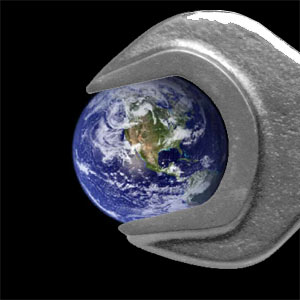
Harvard’s David Keith Knows How To Dial Down the Earth’s Thermostat. Is It Time To Try? I’m still skeptical of geoengineering, but if we continue to drag our feet and delay any substantive cuts in greenhouse gas emissions, it may be one of the few options left in 20 years. Here’s a clip from a story at Re/code: “…The second-largest volcanic eruption of the last century occurred on the afternoon of June 15, 1991, when the summit of Mount Pinatubo collapsed. The stratovolcano, on an island in the Philippines, blasted 20 million tons of sulfur dioxide into the atmosphere. By reflecting away solar radiation, these particles ultimately lowered global temperatures by nearly a full degree Fahrenheit. Keith and others have looked closely at ways of reproducing this cooling effect. Most conclude that it can be done — and relatively cheaply, at that...”

New Dem Leaders Warren, Klobuchar Split on EPA Climate Rule. National Journal has the article – here’s an excerpt: “Two new members of the Senate Democratic leadership team—Sens. Elizabeth Warren and Amy Klobuchar—are pushing the Environmental Protection Agency in separate directions as the agency works to complete its major regulation to cut carbon emissions from power plants. Warren, who will act as a liaison to progressive groups for Senate leadership, wants the EPA rule to cut pollution more deeply. Meanwhile, Klobuchar—the incoming chair of the Senate Democratic Steering Committee—wants to slow down the process, saying the regulation imposes emissions-cutting mandates on states too quickly…”
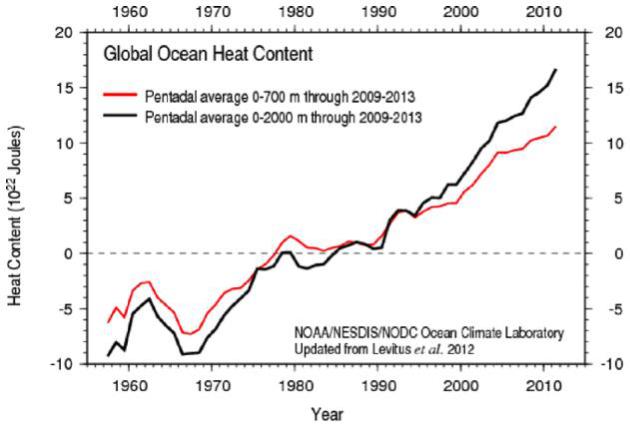
Global Warming Continues, Despite Continuous Denial. St. Thomas climate scientist Dr. John Abraham has the story at The Guardian; here’s a clip: “…First, there has been no pause or even slowdown in the warming of the planet. We provide updated information from NOAA which clearly shows a continued heating of the world’s oceans – the reservoir where most heat ends up. We compare energy contained in different layers and discuss the transfer of energy from the surface regions to the lower regions. When you look at the oceans, the so-called pause is simply a redistribution, a burying of heat to deeper waters...”
Graphic credit above: “Ocean heating data from the National Oceanic and Atmospheric Administration.”
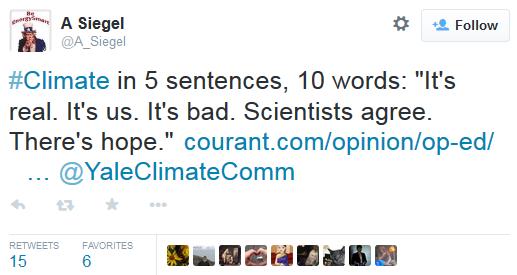
The Great Climate Change Denial Industry. Why? Because trillions of dollars are on the line. This is an existential threat for the fossil fuel industry. When in doubt – follow the money. Here’s an excerpt from a story at The Hartford Courant: “…With respect to “it’s real,” geologists have shown that climate change, rather than stability, is the long-term default condition. Knowing that “it’s us” requires understanding how the earth carbon budget works as a coherent system. Knowing that “it’s bad” requires looking back in time to former conditions reconstructed from the rock record. Knowing that “there’s hope” requires nothing more than learning that Earth is not the fragile planet we’ve been led to imagine. Rather, it’s tough and resistant to anything climate change can throw at it. It’s humanity that is vulnerable…”

Climate Change Isn’t Just Impacting Crops; It’s Taking a Physical and Psychological Toll on Farmers. Is a more volatile climate, with more extreme swings in day to day weather really increasing anxiety levels in the ag community or has it always been like this? Here’s an excerpt of a story at Medical Daily that’s worth a read: “…Like Finnerty, all types of farmers are affected by climate change. For example, produce farmers are constantly rearranging their planting schedules, while livestock and dairy farmers worry about the quality of feed available to their animals. Matthew Russell, a fifth generation Iowa farmer says the past 10 years has made farm life a more anxious environment, as he is constantly concerned over the little time he has to address the changing conditions and its impact on the timing and quality of growing and harvesting seasons. “Psychologically, in the last fews years, there’s a lot of anxiety that I don’t remember having 10 years ago,” Russell told Medical Daily…”
Photo credit: Tim McCabe, USDA.

